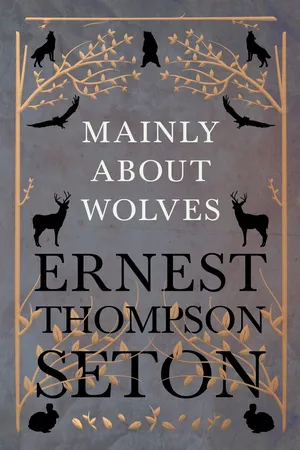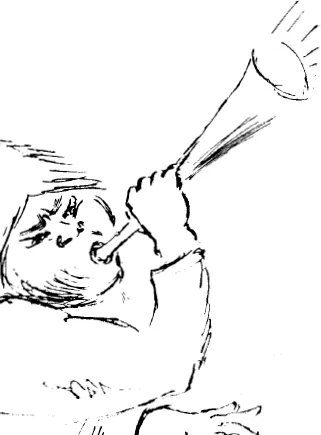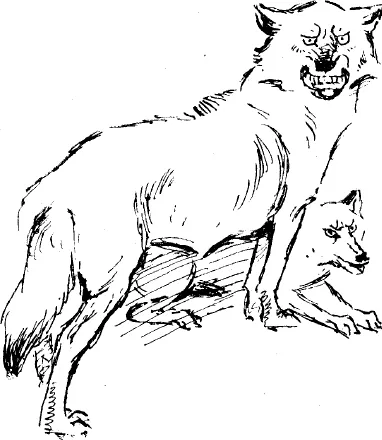
- 358 pages
- English
- ePUB (mobile friendly)
- Available on iOS & Android
eBook - ePub
Mainly About Wolves
About this book
"Mainly about Wolves" is a 1937 work famous American naturalist and writer Ernest Thompson Seton. It explores the subject of wolves, looking their nature and natural history with reference to the author's experiences hunting and tracking them. This classic volume will appeal to those with an interest in wolves, as well as tracking in general and other related outdoor pursuits. Ernest Thompson Seton (1860 – 1946) was an English author and wildlife artist who founded the Woodcraft Indians in 1902. He was also among the founding members of the Boy Scouts of America, established in 1910. He wrote profusely on this subject, the most notable of his scouting literature including "The Birch Bark Roll" and the "Boy Scout Handbook". Seton was also an early pioneer of animal fiction writing, and he is fondly remembered for his charming book "Wild Animals I Have Known" (1898). Other notable works by this author include: "Lobo, Rag and Vixen" (1899), "Two Little Savages" (1903), and "Animal Heroes" (1911). Many vintage books such as this are becoming increasingly scarce and expensive. We are republishing this book now in an affordable, modern, high-quality edition complete with a specially-commissioned new biography of the author.
Frequently asked questions
Yes, you can cancel anytime from the Subscription tab in your account settings on the Perlego website. Your subscription will stay active until the end of your current billing period. Learn how to cancel your subscription.
At the moment all of our mobile-responsive ePub books are available to download via the app. Most of our PDFs are also available to download and we're working on making the final remaining ones downloadable now. Learn more here.
Perlego offers two plans: Essential and Complete
- Essential is ideal for learners and professionals who enjoy exploring a wide range of subjects. Access the Essential Library with 800,000+ trusted titles and best-sellers across business, personal growth, and the humanities. Includes unlimited reading time and Standard Read Aloud voice.
- Complete: Perfect for advanced learners and researchers needing full, unrestricted access. Unlock 1.4M+ books across hundreds of subjects, including academic and specialized titles. The Complete Plan also includes advanced features like Premium Read Aloud and Research Assistant.
We are an online textbook subscription service, where you can get access to an entire online library for less than the price of a single book per month. With over 1 million books across 1000+ topics, we’ve got you covered! Learn more here.
Look out for the read-aloud symbol on your next book to see if you can listen to it. The read-aloud tool reads text aloud for you, highlighting the text as it is being read. You can pause it, speed it up and slow it down. Learn more here.
Yes! You can use the Perlego app on both iOS or Android devices to read anytime, anywhere — even offline. Perfect for commutes or when you’re on the go.
Please note we cannot support devices running on iOS 13 and Android 7 or earlier. Learn more about using the app.
Please note we cannot support devices running on iOS 13 and Android 7 or earlier. Learn more about using the app.
Yes, you can access Mainly About Wolves by Ernest Thompson Seton in PDF and/or ePUB format, as well as other popular books in Biological Sciences & Zoology. We have over one million books available in our catalogue for you to explore.
Information
XVI
La Bête, the Beast Wolf of Gevaudan
1

NEXT after Courtaud of the Paris siege, as an historic figure of surpassing magnitude in the animal world, was the awful beast wolf of Gevaudan. A fearsome giant of the race was the beast, La Bête de Gevaudan, le Loup Garou, the giant wolf; for by all of these names was he known, though most in story as La Bête.
When, after three years of bloody feud with man, he fell, fighting an army of nearly fifty thousand hunters, he was found to be, not a demon, horned and hoofed, but an ordinary wolf of gigantic size, three feet at the shoulder, taller than any mastiff or Great Dane, and above all equipped with jaws that rivalled those of lion or hyene.
Little light is there on his early history. What there is might be called myth or surmise. There is a story told by a hunter, a braconnier, Pierre Cuellac, of Lodève in Mercoire, that he by long craft and careful tracking had found the den of a mother wolf; and yet, strange to relate, herein not one but two mother wolves had joined their homes and their broods. The females fled at his approach, for he came with hounds and with armed men; and he, Pierre, the bravest of them all, crawled into the rocky ledge, and there shivering before him, or in some cases growling defiance, he found no less than twelve wolf cubs, a double brood. Mindful of the bounty on every wolf, he slew them, one by one, except the last. That one was a little larger, and a little darker, and a little more defiant than the rest.
Cuellac was held for a moment by the old forester tradition: ‘Thou shalt not take all the eggs; thou shalt not kill all the brood; leave some for seed or comfort.’ And, as he halted in his bloody work, he saw in the farthest corner—yes, he swears it—that this, the last fell pup of an ill-born race, did raise his right forepaw, and on his black and impish visage made the true sign of the Cross. The torches flared a little brighter, and gave a perfect view. Cuellac swears it; and whether the pious act meant devil or devotee, he bowed to the holy sign and backed him from the cave, with eleven dead wolflings dangling from his hands.

Thus one, the choicest of the double brood, was left; and, having two fond dams to feed and foster, he grew as never wolf had grown before. Three years later—so the forest folk believe—he came forth as Loup Garou, La Bête, a giant demon with a charmed life, the dreaded Loup de Cevennes, the Loup Garou with a mission of revenge, vengeance for the death of his brothers, the avenger of mother and foster-mother; ten human lives, it seemed, was his demand for every single kinsman that they slew.
2
It was in the spring of 1763. Old Cuellac, the shepherd, father of Cuellac the braconnier of Mercoire Forest, who raided the wolf den, was herding his sheep on this side Ardèche where its lush pastures slope to the lordly Rhone. They were indeed the very sheep that the family had bought with the blood-gold, the bounty paid for each of the slaughtered cubs that long-gone day.

Among his kind, old Cuellac was accounted wealthy, for the bounty cash was ten livres for a scalp; and eleven times ten being one hundred and ten, would buy some fifty-five sheep, which in these three years gone, had multiplied to one hundred ewes, though table toll was weekly taken by the family of their owner.
And Cuellac père, reclining on a bank with his trusty sheep dog, found pleasure in noting the bulging bellies of the ewes, the promise of a new engenderment.
He was chewing the root of a calamus, or water-weed, for these folk knew not the solace of a pipe. He had taken off a sabot to shake it free of pebbles from the outer world, when a growl of alarm from black Fidel set him agape; and the sudden scurrying and bleating of the sheep completed a scene of terror; for there among and around the helpless bleaters were two grim wolves, one of enormous size, the other less. They were slaughtering sheep even as a man with a club might slaughter rabbits in a pen, when at them, valiant in his righteousness, dashed brave Fidel.
It was the work of a moment for these two great monsters to seize the poor devoted dog, and rend him body and limb. Then on the sheep they sprang again; but Cuellac went racing to the spot, and with his iron-bound shepherd’s staff he smote both right and left at the circling raiders. They turned on him. With his back against a rock, he faced them; and he slashed and thrust and yelled the shepherd cry for help: ‘Aux secours! Aux secours! Le Loup! Le Loup!’

But his arm was weakening. Many a blow that missed robbed him of power; and, though he heard afar and nearer a hunter in response, ‘Venons! Venons!’ the wolves closed in; old Cuellac was downed. His throat and body were protected with his goatskin kirtle; but he was down on his face, partly under a rock, the grim wolf chopping, tearing the flesh from his thighs and legs, as the hunter horn was heard, and a burst of belling from the wolfhounds. Then the two grim wolves pricked up their ears, wheeled, passed from view like drifting storms of dust.
A moment later, the hounds with the huntsmen arrived. Young Cuellac it was, and what a scene! A dozen sheep were dead, a score at least were wounded, and others stampeding in stupid terror; while, here in the centre of the group was staunch Fidel, dead—stone dead; and old man Cuellac soon to follow on the same dark trail.
His son raised him a little, gave him wine from a hunter’s flask, and in faltering accents the old man told the tale: ‘A giant wolf! A three-times wolf, mon Dieu! Dark, very dark of front, and three light bars like streaks of sunlight on his ribs! A monster! A Loup Garou! Mon Dieu! Water! Water! Help me, Sainte Vièrge! Mon Dieu! Mes Moutons! Sacré—parbleu! Mon fils! Oh-h! Dieu!’
And old Cuellac was dead.
This was La Bête’s first fell attack on man, so far as known. But others in the near past were now charged against him. And this much is certain: on this very day it was that the brute learned man-meat was good, and thenceforth the dread beast of Gevaudan a man-eater became.
3
The very next day, without delay, the countryside assembled for a fight ‘to the death’ they said. Vows of vengeance from near relatives, wild announcements from irresponsibles, and the public notification by the Seigneur de Florac that double bounty would be paid for the scalp of La Bête—twenty livres, a fortune surely in itself.
There were houndsmen and hunters there as good as Pierre Cuellac, but it seemed the right and proper thing to make him captain of this hunt.
To the very spot they went where the tragedy had taken place. The rabble was cautioned to hold back while Pierre with three or four good men, louvetiers who knew the hounds, went forward on the trail of yesterday.
Before they had gone two miles, they crossed a swampy place; and in the mud read this: that two wolves had been there the day before—one a big strong giant wolf with paws like a bear’s; the other much smaller, probably a female, for they ran in pairs, and the small one dragged a crippled limb. How this did hearten men and dogs!
The bugle sounded the fanfare that meant ‘Come on!’ and the waiting rabble at the rendezvous responded with a cheer.
The going had been slow, for the scent was cold. But the hunters followed the limiers, the fine old bloodhounds with the marvellous noses, and were led ever faster till they reached a basking-place where the wolves must have tarried for hours. After that, the scent was good and the pace grew hot.

It was nigh the nooning when amidst the roar augmenting, a new loud note—a trumpet note— ta-ra-ra-ra, announced to all the world that the quarry was in view—the wolves, a giant and a lesser grey—the very same of yesterday’s tragedy.
Then there was a marvellously short run, when the yelping of the hounds and later the huntsman’s horn announced that the quarry was at bay. Where? How? What?
The wiser hunters went ahead, and learned the truth. The chase was short because the lesser wolf was too crippled to run, and the big one would not leave her.
The grim bandits had chosen a good place for the final stand—between two rocks in a tangled thicket. The dogs were all around; but the big wolf faced the front way and the lesser wolf the back.
There was much loud mouthing from the dogs, but nary one would venture in. Those jaws meant certain death to the first at least.
Now did Cuellac crawl up between the dogs. With him were men that carried bows and arrows, some flintlocks, and one a short thick blunderbuss. But to use these now would more likely hurt the dogs than the wolves. So Cuellac crawled around behind, hoping for a higher stand. He got a good look at the lesser wolf, fighting bravely on three legs. He climbed to a higher rock, called for a bow, and at short range from up above, he pierced her through and through. Her scream of pain brought great Garou to her side; he drew the arrow with his teeth, then laid about among the dogs.
The huntsman yelled: ‘Charge, or we lose every dog!’ The rabble closed with yells, with spears and blasts of powder and of horn. They closed in from the front. The one way open was the back; so the great wolf sprang over the corpses of his foes and of his loved one, and away—unwounded, quite unharmed, his courage unshaken, but his wild fierce soul aflame with hate, a-craze for soon revenge.

4
The hunters crowded around, helped this and that big hound with bandage or with lotion-balm. Not a few were dead, gashed dead by the great jaws; and at the farther end, the body of his mate, a she-wolf, that had elsewhere looked a monster, but seen as she was by Garou’s side, seemed small.
The arrow had pierced her vitals. The crippled leg was surely the work of old Cuellac’s shepherd crook.
‘Yes,’ said Pierre Cuellac, ‘I am sure it is the same. This grim brute that killed my father is the dark-visaged cub that, in that den three years ago, forfended death, made me hold back by his cursed use of the blessed sign—a demon wolf, a Loup Garou. I felt it then! I know it now! But, by the blessed sign that he profaned, I swear I will never quit! I will follow, follow, while my strength holds out, till he or I lie low.’
It was not late in the day, but the rabble had no further stomach for the fray; and, bearing as a little triumph, the body of the she-Garou, they scattered homeward, some to vow they sought no more such hunting, some to plan protection for their herds; he, Cuellac, to prepare for a new hard hunt with better weapons, fiercer dogs, and priestly bans and amulets with which to fight the demon wolf, uncharm the charm which guarded Loup Garou.
5
Meanwhile Loup Garou went galloping, galloping, galloping, over moor and timberland, listening without fear for the yelling pack that might be following. But they came not; they had paid heavy toll for their little victory. Nor dog nor man minded then for further adventuring.
Little is known of his line of travel, but this much later was divined from sundry tracks and glimpses of the beast: he had reached the environs of the little parish of Marvejols; and, though he surely must have been hungry, he passed some sheep, some calves—all easy prey—and, overleaping a fence, confronted the f...
Table of contents
- Cover
- Copyright
- Title
- Preface
- Contents
- I Wosca and her Valiant Cub
- II The Chillingham Bull
- III Little Marie and the Wolves
- IV The Wolf on the Running-board
- V The Wild Ways of Tame Beasts
- VI Padraic and the Last of the Irish Wolves
- VII Rincon, or The Call in the Night
- VIII The Wolf and the Primal Law
- IX The Story of Carrots
- X Chicaree
- XI The Woman Bear
- XII The Lovers and the Shining One
- XIII The Rat and the Rattlers
- XIV Dipo: Sprite of the Desert
- XV Hank and Jeff
- XVI La Bête, the Beast Wolf of Gevaudan
- XVII Courtaud, The King Wolf of France
- XVIII The Leopard Lover
- XIX Who were the Heroes?